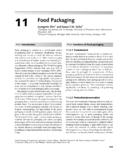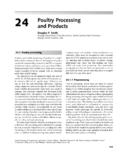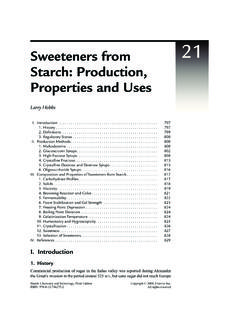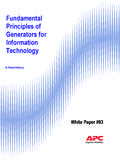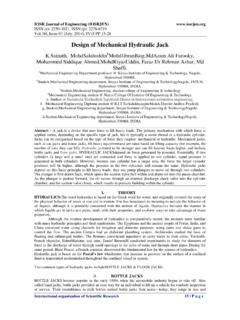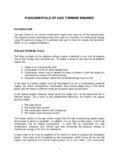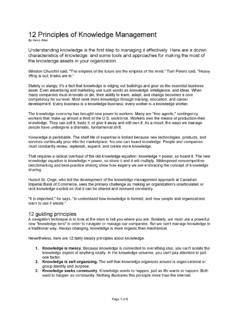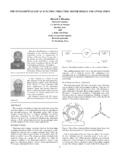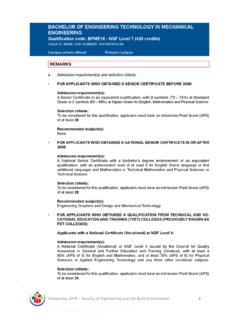Transcription of 1 Principles of Food Processing - Texas A&M …
1 Principles of food Processing 1 Sung Hee Park,1 Buddhi P. Lamsal,2 and Balasubramaniam1,3. 1. Department of food Science and Technology, The Ohio State University, Columbus, Ohio, USA. 2. Department of food Science and Human Nutrition, Iowa State University, Ames, Iowa, USA. 3. Department of food Agricultural and Biological Engineering, The Ohio State University, Columbus, Ohio, USA. Processing of foods: an introduction ensure targeted removal of these hazards so that consu- mers enjoy safe, nutritious, wholesome foods. With the Processing of foods is a segment of manufacturing industry possibility of extending shelf life of foods and advances that transforms animal, plant, and marine materials into in packaging technology, food Processing has been cater- intermediate or finished value-added food products that ing to consumer convenience by creating products, for are safer to eat.
2 This requires the application of labor, energy, example, ready-to-eat breakfast foods and TV dinners, machinery, and scientific knowledge to a step (unit opera- on-the-go beverages and snacks, pet foods, etc. food tion) or a series of steps (process) in achieving the desired Processing , as an industry, has also responded to changes transformation (Heldman & Hartel, 1998). Value-added in demographics by bringing out ethnic and specialty ingredients or finished products that satisfy consumer needs foods and foods for elderly people and babies. Nutrition and convenience are obtained from the raw materials. fortification, for example, folic acid supplementation in The aims of food Processing could be considered wheat flour, is another function of Processing food .
3 Four-fold (Fellows, 2009): (1) extending the period during The scope of food Processing is broad; unit operations which food remains wholesome (microbial and biochem- occurring after harvest of raw materials until they are ical), (2) providing (supplementing) nutrients required processed into food products, packaged, and shipped for health, (3) providing variety and convenience in diet, for retailing could be considered part of food Processing . and (4) adding value. Typical Processing operations may include raw material food materials' shelf life extension is achieved by handling, ingredient formulation, heating and cooling, preserving the product against biological, chemical, and cooking, freezing, shaping, and packaging (Heldman &. physical hazards.)
4 Bacteria, viruses, and parasites are the Hartel, 1998). These could broadly be categorized into three major groups of biological hazards that may pose primary and secondary Processing . Primary Processing a risk in processed foods. Biological hazards that may is the Processing of food that occurs after harvesting or be present in the raw food material include both patho- slaughter to make food ready for consumption or use in genic microorganisms with public health implications other food products. Primary Processing ensures that and spoilage microorganisms with quality and esthetic foods are easily transported and are ready to be sold, eaten implications. Mycotoxin, pesticide, fungicide, and aller- or processed into other products ( after the primary gens are some examples of chemical hazards that may Processing of peeling and slicing, an apple can be eaten be present in food .
5 Physical hazards may involve the pres- fresh or baked into a pie). Secondary Processing turns ence of extraneous material (such as stones, dirt, metal, the primary-processed food or ingredient into other food glass, insect fragments, hair). These hazards may acciden- products. It ensures that foods can be used for a number tally or deliberately (in cases of adulteration) become part of purposes, do not spoil quickly, are healthy and whole- of the processed product. food Processing operations some to eat, and are available all year ( seasonal foods). food Processing : Principles and Applications, Second Edition. Edited by Stephanie Clark, Stephanie Jung, and Buddhi Lamsal. 2014 John Wiley & Sons, Ltd. Published 2014 by John Wiley & Sons, Ltd.
6 1. 2 food Processing : Principles and Applications In the previous example, baking of the pie is a secondary introduction to these Principles is given in this chapter;. Processing step, which utilizes ingredient from primary more detailed information about the theory behind the Processing (sliced apple). Principles and applications can be found in standard food The food and beverage manufacturing industry is one of or chemical engineering textbooks, including Singh and the largest manufacturing sectors in the US. In 2011, these Heldman (2009), Welti-Chanes et al. (2005), and McCabe plants accounted for of the value of shipments from et al. (2001). all US manufacturing plants. Meat Processing is the largest During food Processing , food material may be com- single component of food and beverage manufacturing, bined with a variety of ingredients (sugar, preservatives, with 24% of shipments in 2011.)
7 Other important compo- acidity) to formulate the product and then subjected to nents include dairy (13%), beverages (12%), grains and different unit operations either sequentially or simultane- oilseeds (12%), fruits and vegetables (8%), and other food ously. food processors often use process flow charts to products (11%). Meat Processing is also the largest compo- visualize the sequence of operations needed to transform nent (17%) of the food sector's total value added, followed raw materials into final processed product. The process by beverage manufacturing (16%) (Anonymous, 2012; flow diagrams often include quality control limits and/or USDA Economic Research Service, 2013). California adjustment and description of any hazards. Figure has the largest number of food manufacturing plants shows a sample process flow diagram for making ( Frankfurter comminuted sausage.
8 , followed by New York and Texas . Demand for processed foods tend to be less susceptible to fluctuating economic conditions than other industries. Heat transfer Some basic Principles associated with Processing and preservation of food are summarized in this chapter. Heat transfer is one of the fundamental Processing In-depth discussion can be found elsewehwere (Earle & Principles applied in the food industry and has applica- Earle, 2012; Fellows, 2009; Gould, 1997; Heldman & tions in various unit operations, thermal Processing , Hartel, 1998; Saravacos & Kostaropoulos, 2002; Smith, evaporation (concentration) and drying, freezing and 2003; Toledo, 2007; Zhang et al., 2011), including various thawing, baking, and cooking. Heating is used to destroy chapters in this book.
9 Microorganisms to provide a healthy food , prolong shelf life through the destruction of certain enzymes, and promote a product with acceptable taste, odor, and Unit operations in food Processing appearance. Heat transfer is governed by heat exchange between a product and its surrounding medium. The Most food processes utilize six different unit operations: extent of heat transfer generally increases with increasing heat transfer, fluid flow, mass transfer, mixing, size adjust- temperature difference between the product and its ment (reduction or enlargement), and separation. A brief surrounding. Lean meat Fat Grind Remove casing & vacuum, packaging Add 7 C 16 C. curing salt Shower to chill Chopping Imparts flavor (Extract meat protein Smoke &.)
10 And form emulsion) cook (68 C). Add fat at 16 C Hang on truck, Add sweeteners, link (tied) at a fixed length spices Chopping Stuffing Figure Process flow diagram of Frankfurter Emulsion (cellulose casing). comminuted sausage manufacturing. 1 principles of food processing 3. Conduction, convection, and radiation are the three Mass transfer basic modes of heat transfer. Conduction heat transfer Mass transfer involves migration of a constituent of fluid occurs within solid foods, wherein a transfer of energy or a component of a mixture (Singh & Heldman, 2009) in occurs from one molecule to another. Generally, heat energy or out of a food product. Mass transfer is controlled by the is exchanged from molecules with greater thermal energy to diffusion of the component within the mixture.
